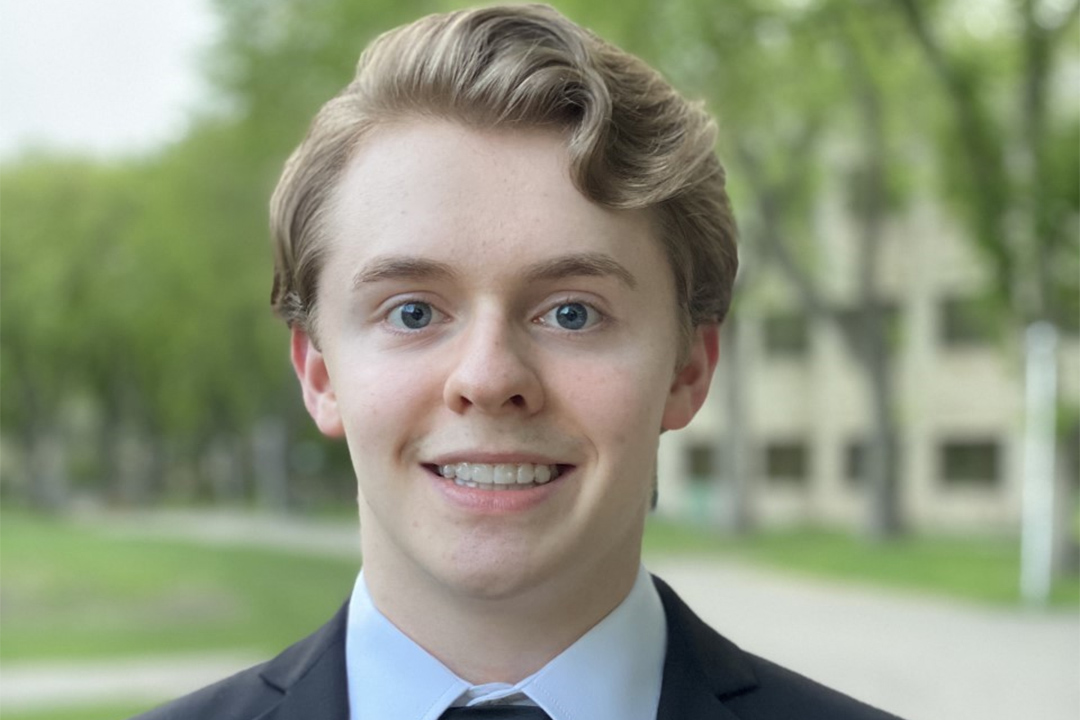
Top USask physics student plans health-care career
Evan Seebach has always been fascinated by physics, noting it can be used to study everything from the smallest particles to the largest objects in the universe.
By SHANNON BOKLASCHUK“What intrigues me the most about physics is the real-world applications,” he said. “Physics is present in everything we do, including our own human physiology. By using the principles of physics we can better uncover the mysteries of the human body.”
It is not surprising, then, that Seebach chose to study physics in the College of Arts and Science at the University of Saskatchewan (USask) after graduating from Saskatoon’s Holy Cross High School in 2016.
He had a great start to his undergraduate studies, receiving the Governor General’s Academic Medal for the highest academic average in his Grade 12 graduating class, as well as a Chancellors’ Scholarship at USask.
This spring, Seebach received a Bachelor of Science (honours) degree in physics from USask, with minors in computer science and mathematics. He graduated with a cumulative average of 94.19 per cent, earning him the Most Outstanding Graduate in Physics award. He also received the Harrington Prize, given to the top graduate in the Department of Physics and Engineering Physics.
“In my four years in the Department of Physics and Engineering Physics I have been surrounded by so many exceptional minds, so I feel very grateful to receive these awards,” he said.
Also notable is that Seebach was awarded a Natural Sciences and Engineering Research Council (NSERC) Undergraduate Student Research Award (USRA) and worked with Dr. Kaori Tanaka (PhD) in the summer of 2019, researching superconductivity and the interplay between superconductivity and charge density waves. During the 2019/20 academic year, Seebach continued working on his research project with Tanaka for PHYS 493.6, the Extended Research Project in Physics course.
“He has performed microscopic studies of nanoscale superconductors and possible interplay of charge density waves and superconductivity. He has written a highly advanced code for solving microscopic equations for superconductivity, utilizing recently developed, efficient numerical algorithms and parallel computation,” said Tanaka, chair of the Undergraduate Affairs Committee in the Department of Physics and Engineering Physics. “Evan is not only bright but also diligent, and his enthusiasm has made it such a joy for me to work with him.”
Outside of his classroom and research work, Seebach served as a Learning Communities peer mentor at USask, meeting weekly with a group of first-year students to provide advice on adjusting to university life. He also took on the role of VP-Internal for the Physics and Engineering Physics Students’ Society, connecting undergraduate students with faculty and staff.
“It was a fun and wonderful experience,” he said. “A main aspect of this role was organizing our student-faculty mixer, where students learn about research opportunities from the faculty and staff. This event was a favourite of mine, because it was at this event in 2018 where I connected with Dr. Tanaka for the first time about joining her research team.”
Seebach was also involved with Peer Health throughout his undergraduate studies. The student-led initiative educates university students on health and wellness topics.
“In my first year with Peer Health, I was a volunteer. Then, in my second year, I became the facilitator of the sexual wellness group, where I organized events including the STI testing blitz—a campus-wide event about breaking the stigma around STI testing,” he said. “In my third and fourth years, I moved into the student co-ordinator position, where I oversaw all of the health events put on by Peer Health.”
Working with Peer Health had a lasting impact on Seebach. As a result, he now plans to pursue a career in health care.
“My experiences with Peer Health have fostered a deep appreciation for helping others, particularly as it pertains to their health and wellness,” he said. “I value how health-care workers are able to provide a level of empathy and care in some of the most difficult times in people’s lives.”
Now that he has graduated, Seebach will consider his next steps and can take some time to enjoy his favourite activities, such as golfing, cooking and baking, and listening to podcasts and audiobooks. Whatever he chooses to do in the future, he will look back with fondness on his time on campus.
“The best part about studying in the College of Arts and Science is that it provided me the opportunity to diversify my studies more than I could have in any other college,” he said. “The College of Arts and Science has a wide range of opportunities, and being a part of it allowed me to pursue physics and a passion for the health sciences.”

